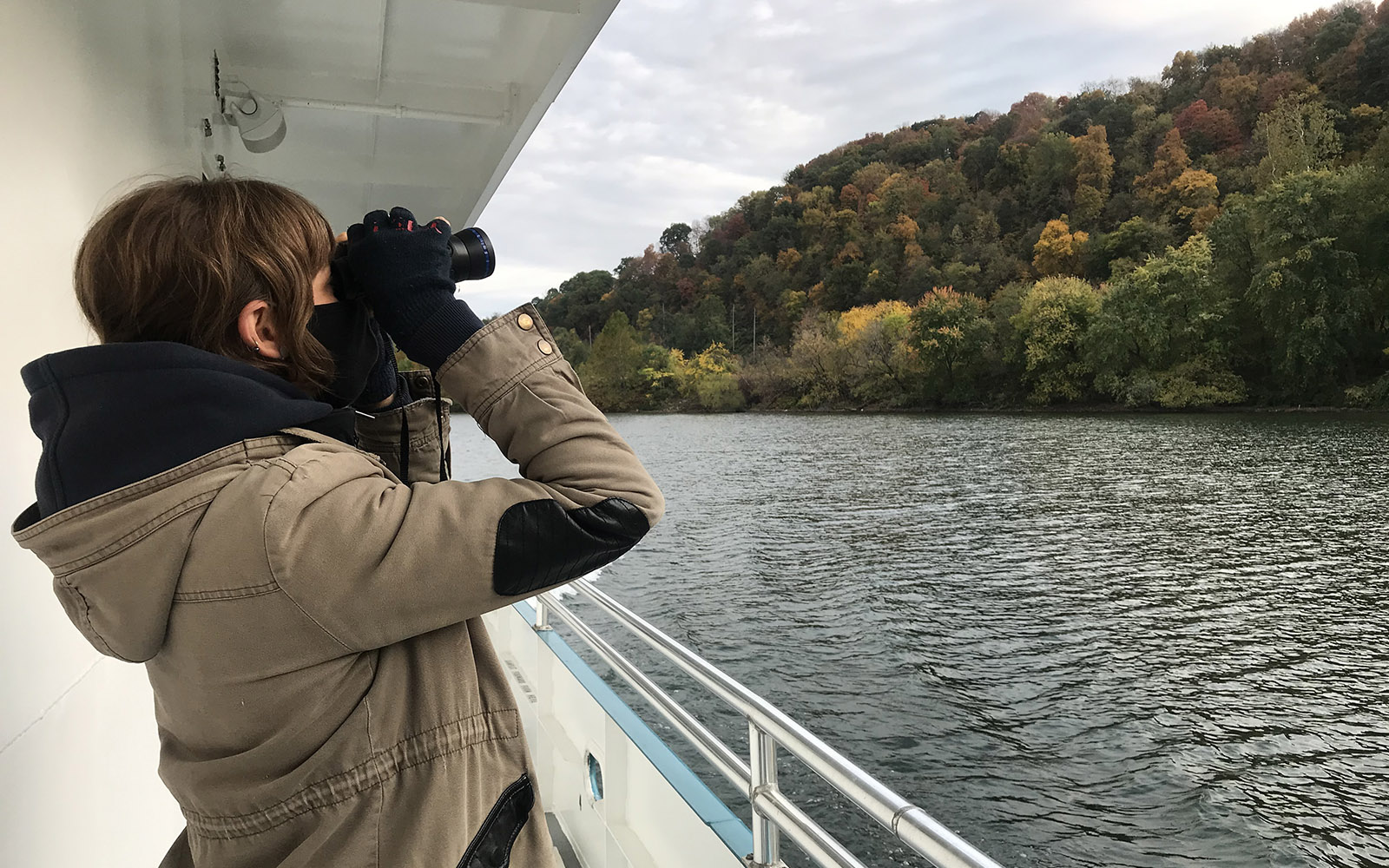
By Angela Biederman, Chief Deckhand | Featured Image: Angela Biederman birdwatching on the Explorer riverboat.
“Birding from Explorer” is an ongoing series of articles by Angela Biederman, Chief Deckhand on the Explorer riverboat. A relatively new birder, Angela shares her observations of migrating birds, as sighted from the boat’s home dock on Pittsburgh’s North Shore, near the headwaters of the Ohio River.
 Migratory Bird Sightings
Migratory Bird Sightings
There have been several sightings of notable migratory waterfowl from the Explorer riverboat since my initial post in December. While the Surf and White-winged Scoters haven’t been seen since my last report, the female Red-breasted Merganser made the shallow waters near our floating dock home for a while. She was around for almost a month, from mid-December to mid-January, and seemed to become quite comfortable in her migratory layover. I’d often see her out diving for food, even in the worst of weather; and saw her climb out onto shore one time, seemingly less spooked by me than she was at first. Similar to Surf Scoters, Red-breasted Mergansers breed much further north, from Alaska and across northern Canada to Newfoundland, summering only as far south as the Great Lakes. During migration, they pass through the continental U.S. to coastal waters. They winter all along the eastern and western coasts, and along the Gulf Coast, preferring saltwater during the coldest months.
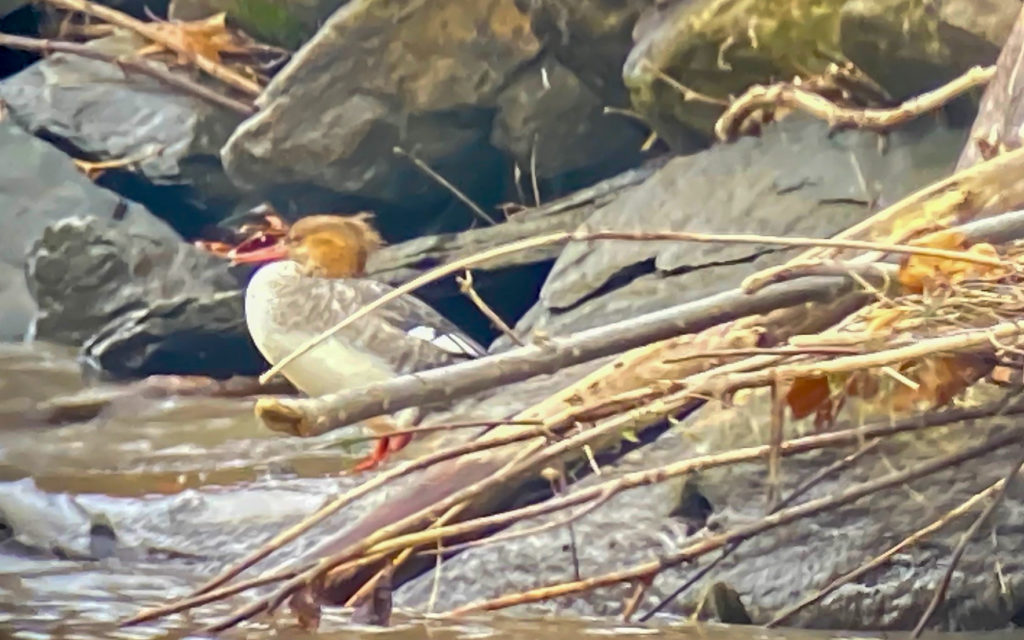
Red-breasted Merganser on Shore
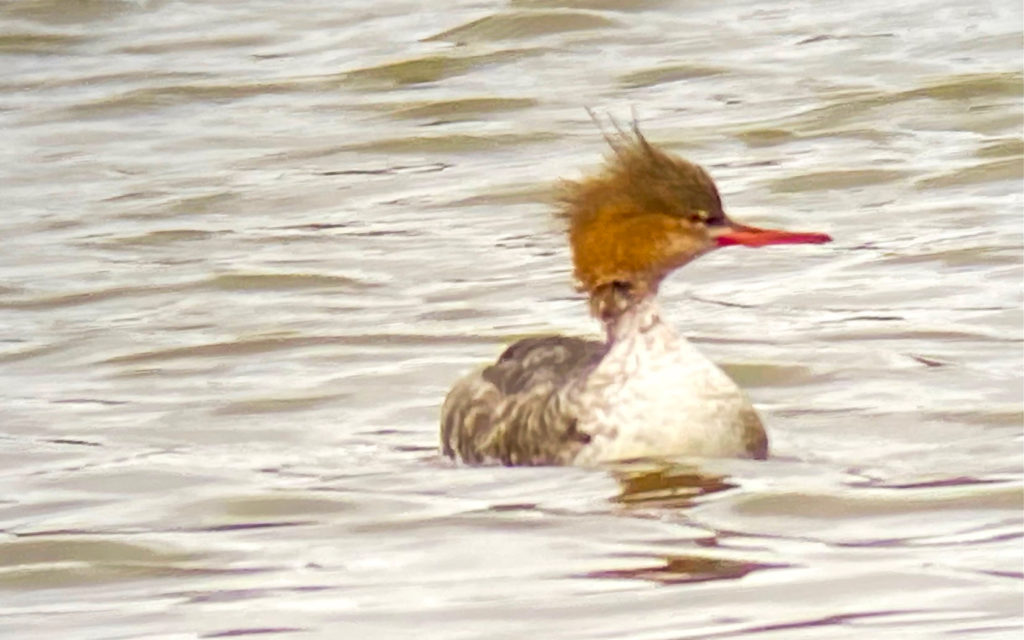
Female Red-breasted Merganser
On December 28, while watching some Pied-billed Grebes near our floating dock through binoculars, another diving duck came right into my zoomed-in view. This new duck was brown with a dark cap, and had light markings on its cheeks. My initial view of it—and excitement!—made me think the Surf Scoter had returned! But on that afternoon, this duck was in no mood for foraging, and was mostly snoozing with its bill tucked into its back feathers. Its position made it difficult to clearly see any facial markings or its bill to identify it for sure. The views and photographs I did get of it made me question whether it was, in fact, a Surf Scoter. I had detected some slight variations and went home to look through my growing collection of bird guides.
Specific traits I noticed were “off” about this diving duck were its tail, facial markings, and bill. I had watched the Surf Scoter a lot, and the differences between it and this diver were subtle, but undeniable. Investigating further, I came across the Ruddy Duck. While the breeding male is very distinct, the females (and winter or non-breeding males) look very similar to female Surf Scoters. Some main differences are that Ruddy Ducks have longer tails; females have light cheeks with a dark stripe (giving the illusion of white cheek patches); and their bills are slightly more curved, and blue to bluish-gray depending on the time of year and sex.
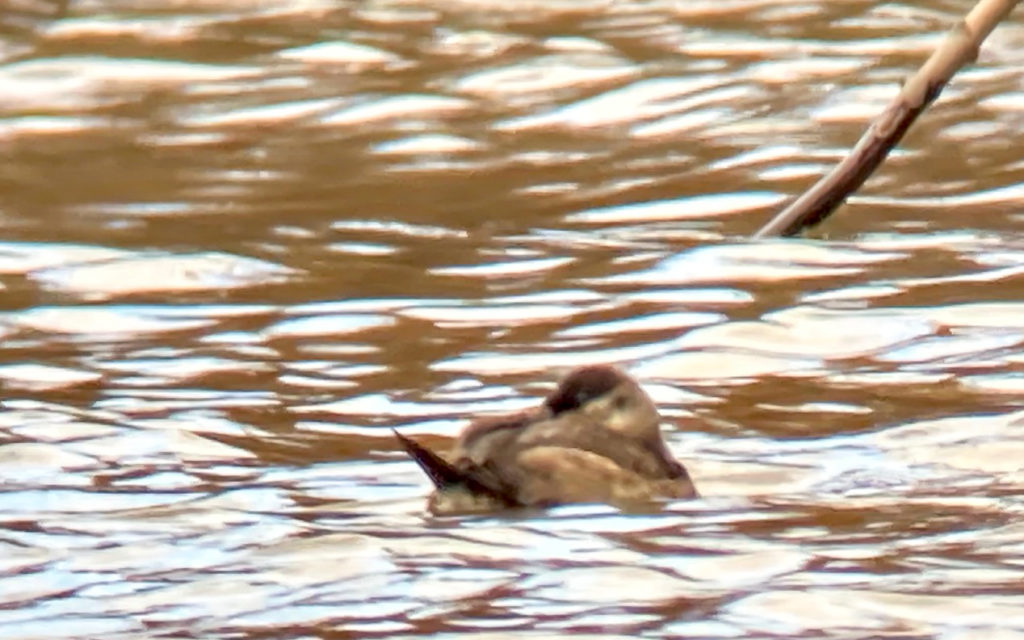
First sighting of female Ruddy Duck
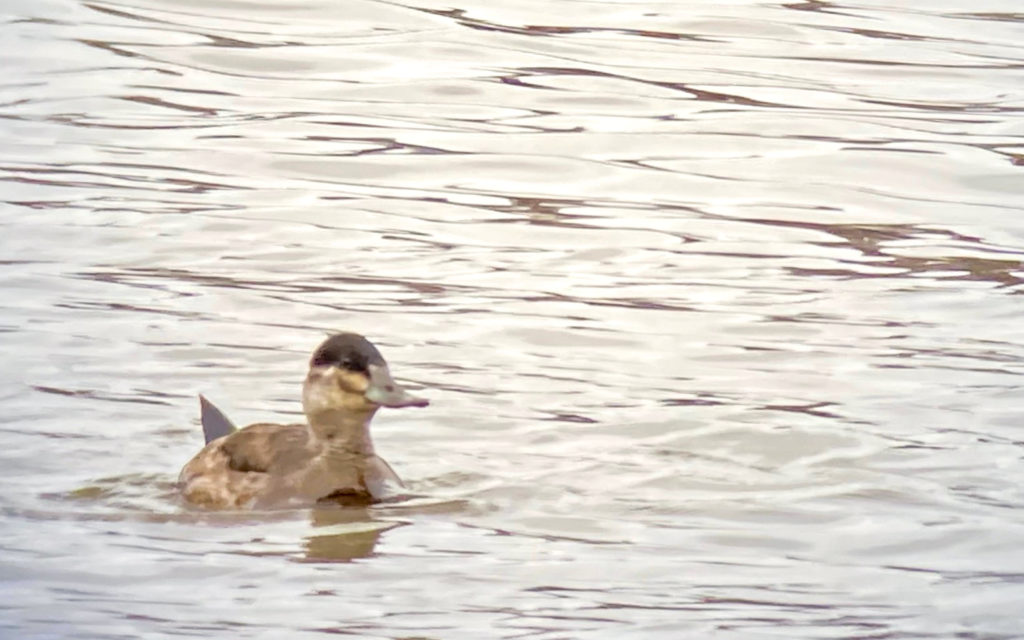
Female Ruddy Duck off Explorer’s stern
I saw the Ruddy Duck and Red-breasted Merganser several times over the next week and a half or so, with the Ruddy Duck also taking a preference for the pool around our floating dock. It seemed the least shy of all the diving ducks I had been spotting: it would swim very close to the stern and hull of Explorer, dive if it saw me move inside or come out on the decks, but wouldn’t necessarily swim away. The last time I saw the Ruddy Duck was January 6, and by that point it seemed that it and the merganser had become the best of friends. I saw them swimming side-by-side off the stern of Explorer for a good ten minutes, and managed to capture this video:
The latest exciting sightings happened all in one day, on January 28. I had just sat down to lunch when I noticed several mostly-white birds swimming up the Ohio River towards the stern of the boat. I got up, grabbed the binoculars, and could barely believe my eyes: FOUR Long-tailed Ducks were swimming upriver! As reported in December, I had seen a lone female Long-tailed Duck, but didn’t know if I’d ever see one again. The first of the four was male, with a very distinguishable, long black tail. The other three were females (or perhaps two females and a juvenile), which were fairly easy to recognize because of the one I had seen two months ago. I managed to capture some photos and videos, and enjoy that I was seeing this species again. In a matter of minutes, a tow boat that was heading downriver startled them into flight. I tried to follow them up towards the bow but lost sight of them. Those few minutes were the only time I saw them.
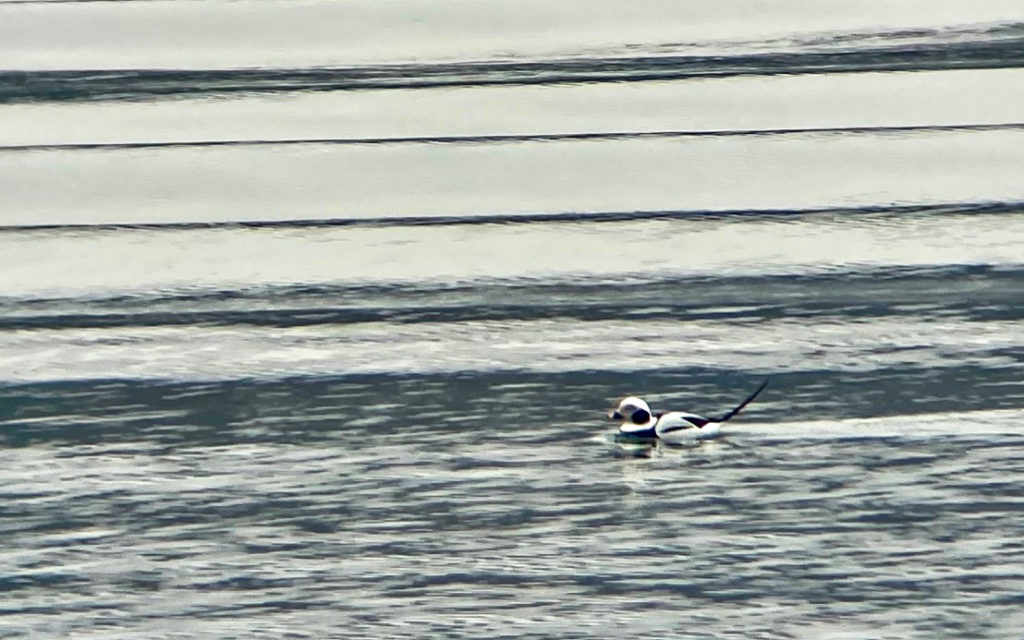
Male Long-tailed Duck
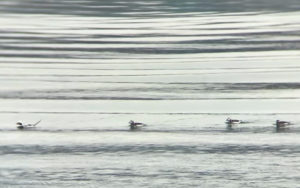
Four Long-tailed Ducks
Later that day, five more diving ducks were spotted in the middle of the channel of the Ohio. They turned out to be Common Mergansers, distinguishable from the Red-breasted Merganser mostly by some variations of plumage and the shape of their crests. Female Commons have cinnamon-red heads and a flatter, single crest—which are cleanly demarcated from a bright white chest. They also have a white chin and slightly broader bill at its base. The Red-breasted Merganser has a more faded red head and spikier, double crest—with less definition from her chin to her grayer, mottled chest.

Female Common Mergansers
In this grouping of mergansers, there were three males and two females. Before this, I had not seen Common Mergansers to my knowledge (again, birding is something I’ve only recently started doing), or any male mergansers. These five mergansers were around for most of the afternoon, but definitely kept their distance. They mostly rested and foraged in the middle of the channel, or closer to the opposing south shore. Common Mergansers are hardy in winter, and often stay as far north as open water permits. They are fairly common in freshwater lakes and rivers, but rarer in saltwater or brackish water, so they typically don’t head for the coasts. I did see the Common Mergansers the next day, but one of the males was gone. I haven’t seen any of them since that second day, and wonder which waters they flocked to.
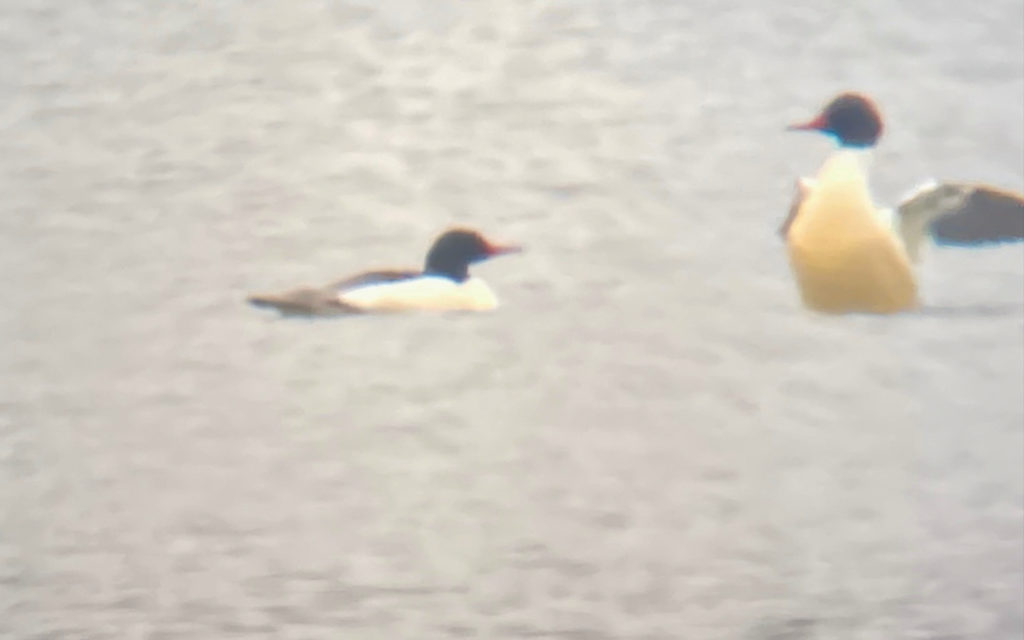
Male Common Mergansers
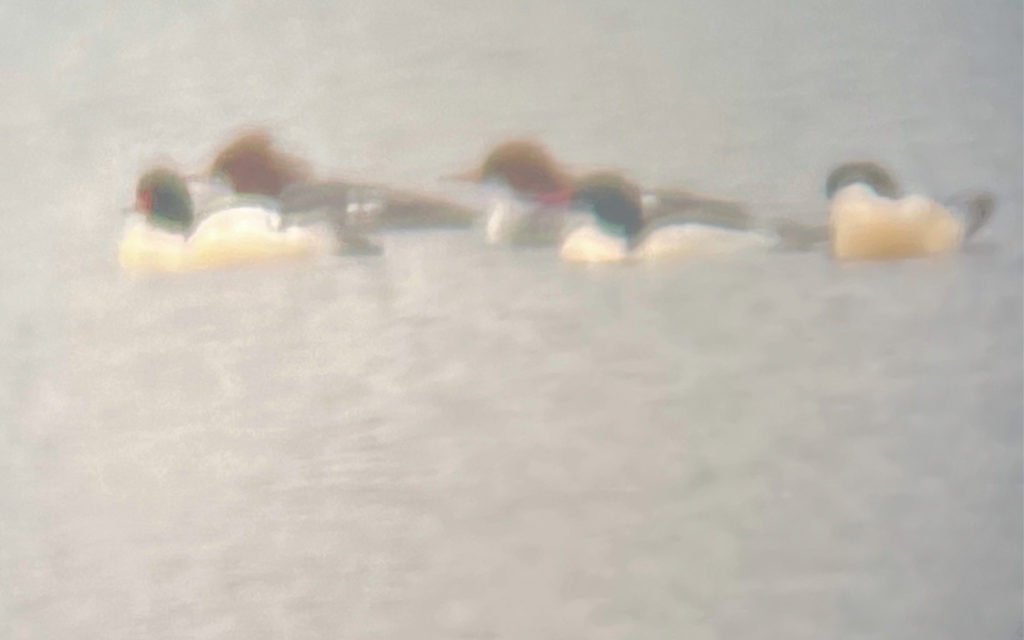
Five Common Mergansers
Angela Biederman began working for Rivers of Steel as a part-time deckhand in March 2018. About a year later, she became the full-time Chief Deckhand, and is responsible for maintaining Explorer year-
This photo essay is the second in a series of articles by Angela highlighting her sightings of migratory birds. All the images of the birds were photographed by her, usually through a set of binoculars with her phone.

 Migratory Bird Sightings
Migratory Bird Sightings





